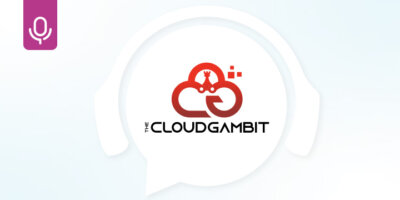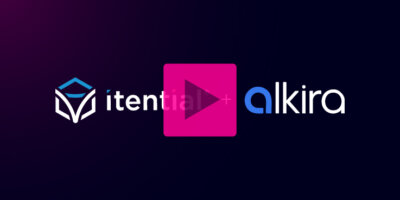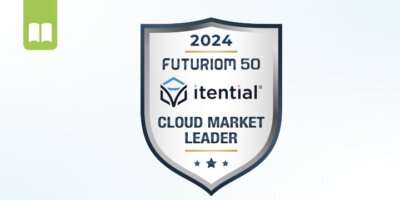Share this

Organizations everywhere are trying to rationalize AI and make sense of the various ways they can implement AI-enabled applications and services to drive value.
But what do organizations need to successfully implement AI? As a recent report from Futuriom explains, “AI doesn’t run on air. It needs a robust cloud infrastructure with advanced automation to support it.”
This report, Driving Cloud Automation with Observability, AIOps, & NetDevOps explores the impact AI is having on hybrid cloud infrastructure and cloud automation strategies. When you think about introducing AI to your organization’s environment, it sounds transformative. And while the technology has potentially transformative implications, it’s important (and perhaps reassuring) for enterprise leaders to understand that enabling AI involves much of the same priorities that hybrid infrastructure has already brought to top of mind.
Futuriom’s report states that “AI is serving as an accelerant to existing cloud infrastructure trends.” This is the key to understanding how to successfully implement AI.
Most organizations are already focused on hybrid and multi-cloud strategies for a number of reasons, with cost control, flexibility, governance, and domain-level tool specificity at the top. Naturally, this shift is driving a need for more automation across multiple clouds, the ability to rapidly deliver data and infrastructure services across a complex environment so your distributed infrastructure is a strength instead of a challenge.
Laying The Groundwork for AI: The Emergence of Hybrid Cloud & The Need for Robust Automation
Over the past several years we’ve seen an explosion in the cloud as organizations look to migrate toward cloud environments wherever possible for flexibility, agility, and cost. While early cloud initiatives focused on single providers, enterprise organizations have shifted away from this approach. Single-provider strategies have proven expensive and limiting compared to multiple cloud approaches — not to mention unrealistic, since individual domain teams within large organizations often made their own cloud decisions based on best fit anyway.
When looking at cloud migration, organizations have prioritized these areas:
- Flexibility
- Scalability
- Affordability
These priorities have naturally pushed organizations toward embracing multiple clouds and building hybrid cloud strategies. Hybrid cloud describes an operational model where a distributed, multi-cloud infrastructure ecosystem can function like one large entity, allowing organizations to orchestrate and manage services among different systems, domains, and platforms and use compute, networking, and storage resources no matter where they reside.
Futuriom’s report identifies a strong trend toward hybrid cloud “as IT managers think about the best ways to optimize and balance their infrastructure in a combination of private infrastructure, public cloud, and edge-compute resources.”
Successful hybrid cloud strategies require robust, mature automation. To rapidly and efficiently orchestrate services across distributed infrastructure, domain-specific capabilities must be exposed as automated services that can easily be coordinated to form multi-domain, multi-cloud workflows.
As workloads increase, the need for efficient automation and orchestration across multiple clouds only increases too. Trends like data analytics and digital transformation have driven enterprise leaders to focus more heavily on hybrid cloud automation strategies. Now, as we enter the ‘age of AI,’ we can view AI as a similar trend that’s just demanding even more—more connectivity, more data, more speed, more automation.
In this way, leaders can look at enabling AI as an extension of what’s already happening with hybrid cloud automation needs, just dialed up to eleven.
The Future of Infrastructure: AI Powered by Mature Hybrid Cloud Orchestration
When we talk about AI, we’re talking about two things: high potential, and high risk. AI can be introduced to your infrastructure in a variety of ways. Whether it’s AI applications supporting developers, AI smart interfaces that can receive IT requests and query downstream systems to deliver outcomes, AI customer support agents that must access user data, generative AI technology can deliver transformative technological and business benefits. But the mistakes AI models make and the risk of AI without oversight can cause significant harm.
All of this means, we need to move ahead with AI, and we need to ensure we have robust systems for governance, observability, delivering accurate data to systems of record, and ensuring AI systems are given the ability to act while also kept under strict controls.
In other words, it means we need more speed, more connectivity, more security, and more governance and observability.
Hybrid cloud automation initiatives require all of the above, and organizations are already seeing a greater convergence between observability and automation. Futuriom’s report explains that cloud observability and automation are already becoming more tightly integrated, as organizations seek to automate more workloads while building in critical governance capabilities. With AI, we’re put in a position where this becomes more important than ever.
If we do it right, if organizations are able to implement secure automation and observability across distributed hybrid cloud environments and provide AI systems with the ability to rapidly query information and make changes while under strict controls and policies, then we will see an era of radical transformation in terms of how infrastructure works for people. Inside and outside your organization, at every level: security teams, application developers, network operators, customers, leaders, everyone can benefit from scalable, responsible, effective AI implementations.
AI is driving organizations to accelerate hybrid cloud strategies and adopt automation at an increasing rate. Those who do the best job, who can implement AI without compromising on governance, will see significant benefits.
Learn more about why the data and automation needs of AI are driving hybrid cloud automation and why hybrid cloud automation is bringing technologies like NetDevOps, AI, and observability together by reading the full Futuriom report here.




